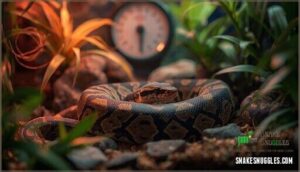This site is supported by our readers. We may earn a commission, at no cost to you, if you purchase through links.

The timeline depends on a cocktail of factors: ambient temperature, prey size, your snake’s species, and even its age. A ball python digesting a small mouse in ideal conditions might finish in 4-6 days, but drop the temperature a few degrees or double the meal size, and you’re looking at two weeks or more.
Understanding this process isn’t just fascinating biology—it’s essential knowledge that’ll help you nail your feeding schedule and spot potential health issues before they become serious.
Table Of Contents
- Key Takeaways
- Snake Digestion Process
- How Long Does Snake Digestion Take?
- How Can You Know Your Ball Python is Done Digesting Their Meal?
- What Size Prey Should You Feed Your Ball Python at Each Meal?
- How Often Do You Need to Feed Your Ball Python?
- When Should You Feed Your Ball Python Again After The Last Meal?
- What to Do When Your Ball Python Won’t Eat
- How Long Does It Take for a Snake to Digest a Mouse?
- Frequently Asked Questions (FAQs)
- What Factors Can Slow Down Snake Digestion?
- Are There Any Risks Associated With Feeding Snakes?
- What Should You Do If You Suspect Your Snake Has Eaten Too Much?
- Are There Ways to Stimulate a Snake’s Appetite?
- Is It Normal for a Snake to Vomit After Eating?
- What happens if a snake eats too large prey?
- Can snakes digest fur and hair completely?
- Do snakes need water during the digestion process?
- How does shedding affect a snakes digestion?
- What signs indicate digestive problems in snakes?
- Conclusion
Key Takeaways
- Snake digestion time hinges on temperature, prey size, and species—warmer environments (28–33°C) cut digestion to 3–5 days, while cold conditions extend it beyond two weeks.
- Post-feeding handling within 48–72 hours triggers regurgitation and organ damage, so avoid disturbance until the feeding bulge disappears and your snake resumes normal activity.
- Prey size must match or slightly exceed your snake’s mid-body diameter; oversized meals exceeding 1.5 times girth cause impaction, internal hemorrhaging, and potential gut rupture.
- Feeding frequency scales with age—hatchlings need meals every 5–7 days, juveniles every 7–10 days, and adults every 3–6 weeks; wait for defecation (5–10 days post-feeding) to confirm digestion completion before the next meal.
Snake Digestion Process
The elegance of snake digestion lies in its extreme specialization. You’re watching a predator that swallows prey whole—no chewing, just 200 backward-pointing teeth that grip and guide food down. Once inside, the snake’s J-shaped stomach unleashes hydrochloric acid and proteolytic enzymes that dissolve muscle, bone, and organs over days.
Snakes swallow prey whole, then unleash digestive acids and enzymes to dissolve muscle, bone, and organs over days—an elegantly specialized predatory system refined through evolution
Snake metabolism shifts dramatically post-feeding; the intestinal mass can double within 24 hours, and metabolic rates spike up to 44 times baseline. This isn’t quick—digestion time depends on prey size, species, and temperature. Warmer conditions accelerate enzyme activity and nutrient absorption, while cooler environments slow everything down, sometimes extending the process to two weeks or more.
The snake’s ability to digest large prey is influenced by its digestive system processes that allow for efficient breakdown of food.
How Long Does Snake Digestion Take?
Digestion time in snakes isn’t one-size-fits-all—it depends on the meal’s size, the snake’s species, and environmental conditions like temperature. Some snakes wrap up digestion in a few days, while others take weeks or even months to process a large meal.
Let’s break down what affects these timelines and why your snake’s digestive pace might surprise you.
How Long Can a Snake Go Without Eating?
How long can your snake actually survive between meals? That depends on species, age, and environmental factors. Ball pythons, for example, can safely fast for up to six months without health issues, while corn snakes usually manage two to three months. Hatchlings and juveniles need more frequent feeding than adults due to faster metabolism and growth demands.
Temperature plays a huge role too—cooler environments slow snake metabolism, extending fasting durations considerably. During brumation or breeding seasons, many snakes voluntarily refuse food for months as normal behavior. Well-nourished adults tolerate longer feeding intervals than stressed or underweight individuals.
Understanding these starvation limits helps you avoid unnecessary worry when your snake skips a meal. Snakes have unique snake survival capabilities that enable them to survive for extended periods without food.
Why Does Digestion Take So Long?
Why does snake digestion take so long? It comes down to their unique physiology and environmental dependence. Snakes are ectothermic, so their metabolism runs entirely on external heat—digestion time roughly doubles when temperature drops by just 5°C. At ideal temperatures between 30–32°C, a ball python might digest a medium rodent in 4–6 days, but larger meals can stretch that timeline to two full weeks.
The process itself is metabolically expensive. Your snake’s energy expenditure spikes dramatically after feeding—pythons can see metabolic rates jump nearly 15-fold within 36 hours. That surge powers remarkable internal changes: intestinal mass increases by 70%, gut lining thickens by 85%, and digestive enzymes ramp up to liquefy prey from the outside in. This entire digestive efficiency depends on warmth, meal size, and your snake’s species-specific metabolism. Handling during this vulnerable window risks regurgitation, which is why waiting 24–72 hours post-feeding protects your snake’s digestive health and ensures proper food breakdown.
How Can You Know Your Ball Python is Done Digesting Their Meal?
Your ball python will signal when digestion wraps up—you just need to know what to watch for. After feeding, their body goes through a predictable cycle, and recognizing the signs helps you avoid handling mishaps or regurgitation risk.
Here’s what tells you digestion is complete:
- The feeding bulge disappears. Once the visible swelling along the mid-body flattens out, the meal has moved from the stomach into the intestines—usually within 48 to 96 hours depending on temperature.
- Activity levels pick back up. After 48 to 72 hours, your python will start moving around again, basking, and exploring instead of staying curled up in one spot.
- Thermoregulation resumes. When your snake shuttles between warm and cool zones again, its metabolic rate has returned to normal—a clear sign the digestion cycle is wrapping up.
- Defecation occurs. Passing waste 5 to 10 days post-feeding confirms the entire digestive process, from breakdown to absorption, is done.
What Size Prey Should You Feed Your Ball Python at Each Meal?
Getting the prey size right is one of those things that sounds simple but makes all the difference in your ball python’s health. You’ll want to keep in mind three main factors when choosing what to offer at mealtime.
Let’s break down how prey description, snake measurements, and age or weight each play a role in making the right call.
Prey Description
Choosing the right prey for your ball python involves more than just grabbing any rodent—it’s about matching nutritional needs to your snake’s life stage. Rodents like mice and rats deliver roughly 18–22% crude protein and 8–12% fat, providing the macronutrients your snake requires for growth and maintenance. The calcium-to-phosphorus ratio in feeder rodents usually sits between 1.1:1 and 1.5:1, which aids healthy bone development.
Rats offer slightly higher caloric density due to greater lipid content, making them ideal for adult snakes, while mice work well for juveniles given their size and digestibility. Day-old chicks can add prey variety and stimulate natural feeding responses, though they’re lower in fat and calcium, so they’re best used occasionally rather than as staples. Frozen-thawed prey retains about 95% of its nutrients when stored and thawed properly, ensuring food quality without compromising your snake’s health.
| Prey Type | Protein & Fat Content | Best For |
|---|---|---|
| Mice | 18–22% protein, 8–12% fat | Juveniles, smaller snakes |
| Rats | 18–22% protein, slightly higher fat | Adults, long-term maintenance |
| Chicks | Lower fat and calcium | Occasional variety |
Snake Diameter (circumference) Measurement
Accurate diameter calculations require a mid-body measurement at your ball python’s thickest point—usually between the head and cloaca. Use a flexible tailor’s tape, wrapping it perpendicular to the snake’s body axis while the animal is calm and fully supported. Non-stretch tapes improve repeatability and keep measurement errors under 2%. Circumference usually represents 5–10% of total body length, depending on body condition.
For feeding purposes, prey size should match or slightly exceed this mid-body diameter—a guideline that aligns with standard reptile digestion and nutrition charts.
Proper measurement tools and body scaling techniques also inform snake care and feeding decisions but also help you track growth and digestion time over weeks and months. Record values in millimeters for precision, and you’ll gain insight into how snake digestion shifts with temperature and meal size.
Snake Age And/or Weight
Age and weight factors guide feeding precision in ways diameter alone can’t capture. Juvenile ball pythons digest meals in 2–4 days and need prey every 5–10 days, while adults take 7–14 days and eat monthly.
Snake growth stage affects metabolic rate—hatchlings process nutrients faster than subadults. Weight limits matter too: feed 10–15% of body mass for ideal digestion time.
Heavier snakes show metabolic scaling, with slower digestion rate per gram as snake species digestion efficiency shifts with size.
How Often Do You Need to Feed Your Ball Python?
Feeding frequency depends on your ball python’s age and weight—think of it as matching fuel to engine size. Hatchlings under four months need meals every 5–7 days to support rapid growth, while juveniles between four months and one year do well with 7–10 day intervals. Subadults up to 1,000 grams thrive on a feeding schedule every 14–21 days, and adults over 1,000 grams need feeding only every 3–6 weeks to maintain healthy body condition and avoid obesity.
- Adjust feeding frequency as your snake matures. Young ball pythons require frequent meals to fuel growth, but adults maintain their weight with far less—feeding schedules should shift from weekly to monthly as your snake ages.
When Should You Feed Your Ball Python Again After The Last Meal?
The moment your ball python passes waste—usually 5–10 days after eating—is your clearest signal that digestion is complete and the feeding schedule can resume. You’ll also notice the midsection bulge has vanished, your snake returns to normal thermoregulation behavior, and activity levels stabilize. Wait at least 48 hours after defecation before offering the next meal to confirm internal organs have fully returned to their resting size.
| Life Stage | Time After Last Meal |
|---|---|
| Hatchlings (1000g) | 21–42 days |
This table helps you align meal frequency with growth rates and digestion cycles. During cooler months, extend these intervals by 20–30% since metabolism naturally slows. Prioritize body condition over rigid feeding schedules—a healthy ball python maintains consistent weight without visible rib definition or excessive fat deposits.
What to Do When Your Ball Python Won’t Eat
Ball pythons can refuse food for various reasons, and knowing what’s behind the fast helps you address it properly. Some causes are harmless and temporary, while others need your immediate attention.
Let’s walk through the most common reasons your python might be skipping meals.
Systemic Stress
When your Ball Python refuses to eat, systemic stress might be the invisible culprit disrupting everything from metabolism to digestion time. Stress triggers a cascade of physiological changes—your snake’s body diverts energy away from digestion and toward survival, slowing down the entire digestive process and sometimes leading to regurgitation or worse, organ damage.
Environmental factors play a huge role in stress response. Consider these common stressors that impact snake digestion:
- Frequent handling during or right after feeding activates hormone regulation pathways that suppress digestive enzyme production
- Captivity effects like improper temperature gradients or inadequate hiding spots can increase stress hormones by up to 60%
- Sudden environmental changes including lighting shifts, vibrations, or overcrowding trigger the release of corticosterone, which redirects resources away from digestion
The digestion impact of chronic stress is serious—your Ball Python’s system basically hits pause, prioritizing immediate survival over processing that mouse. If you notice persistent food refusal, evaluate your husbandry setup first.
Health Issues
While stress sets the stage for feeding problems, underlying health conditions can directly sabotage your ball python’s appetite and digestion time. Oxidative stress from digestion itself can be substantial, increasing cellular damage by roughly 180% compared to fasting states. When illness compounds this natural burden, your snake’s system struggles. Watch for regurgitation causes like repeated meal expulsion, lethargy, or visible bloating—these signal potential organ damage or putrefaction inside the digestive tract.
Infection risks from bacteria like Salmonella—present in over half of all snakes—can worsen when your python is already compromised, slowing digestive enzyme activity and sometimes triggering regurgitation. Parasite control becomes critical here; cryptosporidiosis causes severe digestive disorders, weight loss, and malabsorption that often prove fatal without intervention.
| Health Issue | Impact on Snake Digestion |
|---|---|
| Parasitic infections | Malabsorption, chronic indigestion, weight loss |
| Bacterial overgrowth | Slowed digestion time, increased infection risks |
| Inclusion Body Disease | Gastrointestinal tissue damage, metabolic disruption |
| Dehydration | Impaired enzyme function, regurgitation risk |
If feeding refusal persists beyond two weeks or you spot warning signs, consult a reptile veterinarian immediately for diagnostic testing.
Rejection of Food Type
Beyond health troubles, your ball python may simply be telling you it doesn’t like what’s on the menu. Early feeding experiences shape prey preference powerfully—juveniles fed only mice show an 80% chance of refusing rats later. That’s dietary selectivity at work, and it directly affects digestion time since snakes won’t process meals they reject outright.
Olfactory cues drive feeding responses through chemoreception. When frozen prey loses its scent during thawing, up to 50% of feeding attempts fail. Warming prey to 37°C mimics living thermal signatures and boosts strike probability markedly. If your python consistently refuses a particular food type, switching back rarely works—repeated exposure to non-preferred prey doesn’t increase acceptance as you’d expect.
Consider these factors when meal rejection happens:
- Scent matters more than appearance: Pre-scenting enclosures with preferred prey odor raises acceptance rates by 30%, especially after relocation.
- Temperature affects prey digestion readiness: Ideal feeding occurs between 30–32°C ambient temperature.
- Early imprinting sticks: Long-term feeding on one species reduces acceptance of alternatives due to different olfactory signatures.
Don’t force dietary changes without understanding your python’s established preferences first.
Husbandry Issues
If your python still isn’t eating, look closely at its environment. Enclosure maintenance and temperature control form the backbone of proper digestion—ball pythons need 88–92°F on the warm side and 75–80°F on the cool end to digest efficiently. Anything below 75°F shuts down enzymatic activity, leading to regurgitation within three to five days.
Humidity management matters too; levels under 50% cause retained sheds and respiratory trouble, while dirty substrates spike bacterial loads within 72 hours. Don’t handle your snake within 48 hours of feeding schedules—it triggers stress responses that slow the digestion process entirely.
Check your reptile nutrition setup: covered sides reduce visual stress by mimicking natural hiding spots, and PVC enclosures hold moisture better than glass tanks ever will.
Seasonal Shifts
When husbandry looks solid but your python still refuses meals, seasonal shifts often explain the mystery. Between September and December, many ball pythons enter mild brumation—metabolic rates drop, appetite vanishes, and they’ll fast for three to five months straight without harm.
Ambient temperature drives digestion time directly: a drop from 88°F to 75°F can double how long food sits in the gut, triggering regurgitation instead of absorption.
You’ll notice reduced activity from November through February even in captive setups, since thermal regulation cues persist despite stable enclosure heating. Boost your basking spot to 90°F during cold months and accept that winter fasting mirrors wild patterns—it’s environmental adaptation, not illness.
How Long Does It Take for a Snake to Digest a Mouse?
How quickly can your snake break down a mouse? For most species, expect the process to wrap up in 3–5 days under ideal conditions, though smaller meals digest faster than large prey.
Several factors control digestion time:
- Temperature – Warmer environments (28–33°C) speed up enzyme activity, while cold conditions extend digestion beyond a week.
- Prey size – Larger meals demand more metabolic energy and take longer to process.
- Snake age – Juveniles digest more efficiently than adults due to higher metabolic rates.
- Hydration – Post-feeding water intake aids nutrient absorption and digestive efficiency.
Monitor your snake’s thermal gradient carefully, as proper warmth drives healthy feeding frequency and ideal snake nutrition.
Frequently Asked Questions (FAQs)
What Factors Can Slow Down Snake Digestion?
What keeps your snake’s digestion running smoothly? Temperature, prey size, and stress matter far more than you’d think. Cold environments dramatically reduce metabolic rates—research shows snakes in lower temperatures experience significant metabolic suppression. Larger prey extends digestion cycles substantially. Stress and anxiety further slow your snake’s digestion enzymes and metabolic processes.
Maintain warm, secure conditions to enhance your snake’s digestion cycle and overall health.
Are There Any Risks Associated With Feeding Snakes?
Feeding risks demand careful attention. Improper prey sizing—exceeding 5 times your snake’s girth—causes impaction, regurgitation, and organ damage in up to 15% of captive snakes. Live prey increases injury risk through bites and infections.
Post-feeding handling triggers regurgitation, potentially fatal. Overfeeding causes obesity, metabolic disease, and shortened lifespans.
Match prey to your snake’s body diameter and wait 48-72 hours before handling.
What Should You Do If You Suspect Your Snake Has Eaten Too Much?
When you suspect overfeeding, stop handling your snake immediately—this prevents regurgitation and organ damage. Create a quiet, warm environment and monitor closely for lethargy or bloating.
Avoid feeding for 7–10 days, then resume with appropriately sized prey at 10–15% of body weight. Contact a veterinarian if you notice persistent vomiting or severe distension.
Are There Ways to Stimulate a Snake’s Appetite?
Absolutely. Environmental adjustments and feeding strategies greatly boost your ball python’s appetite. Maintain temperatures between 26–32°C and humidity at 50–70% to enhance metabolism. Reduce enclosure visibility with hiding spots, which improves feeding behavior by 40–60%.
Try scenting prey with lizard or frog odor (60–80% success rates), or offer freshly killed, warmed prey mimicking body temperature. Use feeding tongs to avoid human scent—this reduces refusals by 25%. Feed during peak nocturnal activity (7–10 P.M.) for best results.
Address any stressors like inadequate privacy or improper thermal gradients that suppress appetite.
Is It Normal for a Snake to Vomit After Eating?
Regurgitation happens, though it shouldn’t become routine. When your ball python vomits after eating, stress or improper conditions usually triggered it—not the meal itself.
Cold temperatures, prey exceeding 5 times body diameter, or handling within 48 hours post-feeding commonly cause this.
Address the underlying cause: fine-tune temperature, adjust prey size, and minimize disturbance during digestion to prevent future digestive health issues.
What happens if a snake eats too large prey?
When a snake consumes prey exceeding its capacity, serious complications emerge. Metabolic demands spike four- to sixfold, causing physiological stress and organ strain.
Sharp prey features can puncture the gastrointestinal tract, triggering internal hemorrhaging. Regurgitation, impaction, or even gut rupture may follow, potentially proving fatal without prompt veterinary intervention.
Can snakes digest fur and hair completely?
Your ball python can’t completely digest fur and hair. While digestive enzymes break down flesh and bones effectively, they lack keratinases—specialized enzymes needed to break down keratin, the protein that makes up fur.
Around 75–90% of fur passes through undigested and appears in feces. That’s why you’ll often see fur in your snake’s droppings months after feeding.
Do snakes need water during the digestion process?
Your ball python needs water during digestion. Adequate hydration promotes enzyme activity, boosts metabolic rate, and aids nutrient absorption. Dehydration hinders digestive efficiency, slows digestion, and can cause impaction.
Make sure fresh water is always available—snakes often drink immediately after feeding to enhance the digestion process.
How does shedding affect a snakes digestion?
During your snake’s shedding cycle, digestion takes a backseat. The ecdysis process temporarily reduces digestive efficiency as your snake’s gastrointestinal tissues regress and regenerate.
Digestive enzymes decrease, slowing nutrient absorption. Avoid feeding during this vulnerable period—wait until skin regeneration completes for peak snake metabolism and digestion.
What signs indicate digestive problems in snakes?
Watch for regurgitation—especially repeated episodes—along with abnormal feces (watery, discolored, or containing undigested fragments).
Lethargy beyond normal digestion periods, feeding refusal, abdominal bloating, and difficulty defecating all signal digestive distress warranting veterinary attention.
Conclusion
What’s the real secret to keeping your snake thriving? Nailing the timing. Understanding how long it takes a snake to digest isn’t just trivia—it’s the foundation of proper feeding intervals and preventive care.
Temperature, prey size, and species all orchestrate this biological dance. Get these variables right, and you’ll sidestep feeding mishaps, obesity, and regurgitation.
Your snake doesn’t need fancy feeding schedules; it needs consistency matched to its physiology. Master digestion, and you’ve mastered snake husbandry.
- https://journals.biologists.com/jeb/article/210/2/340/17113/Adaptive-regulation-of-digestive-performance-in
- https://www.sciencedirect.com/science/article/abs/pii/0010406X70900289
- https://pmc.ncbi.nlm.nih.gov/articles/PMC6206181/
- https://www.sciencedaily.com/releases/2015/05/150518081447.htm
- https://pubmed.ncbi.nlm.nih.gov/33400953/













